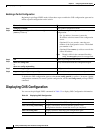
6-2
Catalyst 2950 Desktop Switch Software Configuration Guide
78-11380-05
Chapter 6 Clustering Switches
Understanding Switch Clusters
Understanding Switch Clusters
A switch cluster is a group of connected Catalyst switches that are managed as a single entity. In a switch
cluster, 1 switch must be the command switch and up to 15 switches can be member switches. The total
number of switches in a cluster cannot exceed 16 switches. The command switch is the single point of
access used to configure, manage, and monitor the member switches. Cluster members can belong to
only one cluster at a time.
The benefits of clustering switches include:
• Management of Catalyst switches regardless of their interconnection media and their physical
locations. The switches can be in the same location, or they can be distributed across a Layer 2 or
Layer 3 (if your cluster is using a Catalyst 3550 multilayer switch as a Layer 3 router between the
Layer 2 switches in the cluster) network.
Cluster members are connected to the command switch according to the connectivity guidelines
described in the “Automatic Discovery of Cluster Candidates and Members” section on page 6-5.
• Command-switch redundancy if a command switch fails. One or more switches can be designated
as standby command switches to avoid loss of contact with cluster members. A cluster standby group
is a group of standby command switches.
• Management of a variety of Catalyst switches through a single IP address. This conserves on IP
addresses, especially if you have a limited number of them. All communication with the switch
cluster is through the command switch IP address.
For other clustering benefits, see the “Advantages of Using CMS and Clustering Switches” section on
page 1-6.
Refer to the release notes for the list of Catalyst switches eligible for switch clustering, including which
ones can be command switches and which ones can only be member switches, and the required software
versions.
These sections describe:
• Command Switch Characteristics, page 6-3
• Standby Command Switch Characteristics, page 6-3
• Candidate Switch and Member Switch Characteristics, page 6-4


















